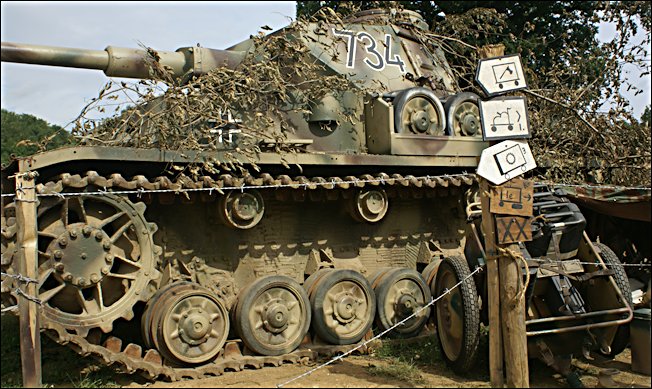The Panzer IV tank number 734
This German Panzer IV tank number 734 is in private ownership and is often seen at military vehicle events in the summer in Britain like the annual "War and Peace" Show in Folkstone.

German Panzer IV tank with the long barrelled 75mm gun
Panzer IV vs Russian KV-1 at Stalingrad
Desperate to buy time, so they could build up strength to counter attack the German invasion of Russia, the Soviet High Command sent in the 1st and 4th Tank Armies to Stalingrad to try and stop the enemy’s advance. They only had 238 T34/76 medium tanks and just 40 KV-1 heavy tanks. Both of these tanks out classed the German Panzer IV medium tank. They were fitted with a superior 76mm cannon and had better armour protection. The Russians were heavily outnumbered.
On 27th July 1942, the Germans advanced to the River Don to seize the man crossing that lead to Stalingrad, which was only 40 miles away. The Russian 1st tank army launched a counter attack to try and stop them. Russian Lt, Vasily Krysov was in one of the leading KV-1 tanks. It was a dawn attack and the Germans had positioned anti-tank guns on the approach to the village that surrounded the bridge. The shells just bounced off the heavy armour of the KV-1 tanks.
He recalls what happened when they broke through the outer defences and stormed into the village. "Our brigade moved towards a farm where the main enemy panzer group was positioned. The ensuing combat was fierce. A panzer IV tank quickly moved in our direction. We turned to face it. I gave the order, ‘halt, armour piercing fire’. The German gun layer beat us to the punch. Their shell just bounced off. When the German tank was hit by our shell it just blew up. My comrades’ tank also set fire to a Panzer IV tank." The Panzer Mark IV tank was no match for the Russian KV-1 heavy especially as the Russians tended to deploy them in mass attacks.

German Panzer IV tank has eight small track wheels. The Panzer III has only six.
How does a rifle bullet stop a Panzer IV tank?
Another problem for the thinly armoured German panzers that were attacking Stalingrad was the Russian 2.5 metre long Anti-tank rifle. Twenty Panzer Mark IV tanks were spotted by a Soviet Anti-Tank Rifle Company, that was positioned in an open field, as they were heading towards the Volga River near Stalingrad.
They had 16 Anti-tank rifles pointing at the oncoming tanks. The shells created splinters inside the crew compartment that caused vicious and sometimes fatal injuries. It a shell managed to hit the panzer’s engine or fuel tanks they could cause an explosion or fire.
One of the lead German tanks caught on fire. Then another went up in flames. A third tank was sent spinning. This was enough to discourage the other tanks about continuing into the hail of fire. They turned around and retreated.

German Panzer IV tank number 734
Operation Winter Storm and the problematic T34/76
The Russians had been able to totally surround the German forces in Stalingrad. The German High Command organised a rescue mission to punch through the surrounding Soviet forces to enable the trapped 6th Army to escape. This attack was called Operation Winter Storm. It moved off from the start line 12th December 1942.
Russian intelligence found out about this offensive and sent columns of T34/76 medium tanks down a valley to engage with their enemy. What they did not realise was that they were heading into the jaws of a German trap arranged by General Erhard Raus, "Russian forces moved out of Verkhne-Kumskiy at dawn. In tank units of this Division moved in long columns. This area was situated in a valley. All of a sudden German tanks appeared over the snow covered hills."
"They slowly advanced towards their victims who as yet were unaware of their impending doom. The concentric attack began with the complete encirclement of the Russian Brigade. The enemy suddenly saw more than two hundred tanks descend from the hills and fall upon his columns. Two hundred guns fired at close range onto the sides of the enemy tanks. The Russian tanks engaged the German tanks coming down the hills in a fire duel for life and death. The enemy attack ended in a tank graveyard."
What was clever about general Raus’ plan was that if the T34/76 tank commander turned to face the tanks coming down the hill to his right and get the protective benefit of the strong frontal sloping armour he risked exposing his weak rear armour to the German tanks coming down the hill on his left.
Unfortunately for the German relief column the same sort of tactic was also used on the later as they advanced towards a river crossing. A squadron of seven Russian T34/75 tanks had found a sand pit opposite the main road down to the crossing. It was big enough to fit all seven tanks. It enabled them to get into a protective 'hull-down' position. All the Approaching German tanks would be able to see were seven turrets sticking out over the edge of the sand bank.
Unfortunately the Panzer IV tank only had 30mm of armour on its side. The Russian tank crews held their fire until the Germans were close. They would set one on fire and then they would hit another one. It was like a turkey shoot. Eleven tanks were destroyed by fire.
WW2 tank books

